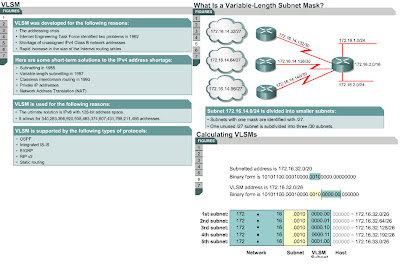VLSM
What is VLSM and why is it used?
1.1.1
Certification-level claim: Compute and use Variable
Length Subnet Masking (VLSM) techniques to design and implement effective and
efficient IP addressing.This module provides essential background information for the CCNA exam. Namely, this is how to configure IP addresses, subnet masks and gateway addresses on routers and hosts, and how to design an IP addressing scheme to meet design requirements.
Hands-on skills: None
In this lesson students will be introduced to the new topic of Variable Length Subnet Masks (VLSM). It is important for instructors to introduce this topic after they have made sure that students are thoroughly familiar with subnetting. It might be useful to give students the opportunity to demonstrate their skills at subnetting by giving them a series of small network addressing problems. These could be such as ones they have done in CCNA 1 and 2. Instructors should then emphasize that VLSM is an important topic and students will now be able to use subnet zero. During this module, try to give the students plenty of opportunities to compute and use VLSM techniques to design and implement effective and efficient IP addressing.
Best practices for teaching this TI include online study with study guides, group work, practical addressing quizzes using VLSM, lab work, and mini-lecture.
This is a core TI.
VLSM is simply an extension of basic subnetting, where the same Class A, B, or C address is subnetted by using masks of different lengths. VLSM provides a more efficient way of assigning IP addresses. It provides more flexibility in assigning an adequate number of hosts and subnets given a limited number of IP addresses. In CCNA 1 and 2, the question may have come up as to why host addresses are used on a WAN link, which only requires one address on either end of the link, plus a network address and a broadcast address. VLSM makes it possible to subnet a subnet so VLSM can be used on WAN links with a Classless InterDomain Routing (CIDR) notation of /30. IP subnet zero is enabled by default on Cisco IOS 12.0 and higher. This allows the use of all zeros and all ones subnets.
Pay particular attention to the following figures:
- Figure outlines that VLSM works with OSPF, IS-IS, EIGRP, RIP v2, and static routing.
- Figure emphasizes the use of the /30 on the serial links.
- Figures and illustrate VLSM and how it is computed.
- Why is VLSM described as subnetting a subnet?
=====================================
As IP subnets have grown, administrators have looked for ways to use their address space more efficiently. This page introduces a technique called VLSM. With VLSM, a network administrator can use a long mask on networks with few hosts, and a short mask on subnets with many hosts. -
In order to implement VLSM, a network administrator must use a routing protocol that supports it. Cisco routers support VLSM with Open Shortest Path First (OSPF), Integrated IS-IS, Enhanced Interior Gateway Routing Protocol (EIGRP), RIP v2, and static routing.
VLSM allows an organization to use more than one subnet mask within the same network address space. VLSM implementation maximizes address efficiency, and is often referred to as subnetting a subnet.
Classful routing protocols require that a single network use the same subnet mask. As an example, a network with an address of 192.168.187.0 can use just one subnet mask, such as 255.255.255.0.
A routing protocol that allows VLSM gives the network administrator freedom to use different subnet masks for networks within a single autonomous system. Figure shows an example of how a network administrator can use a 30-bit mask for network connections, a 24-bit mask for user networks, and even a 22-bit mask for networks with up to 1000 users.
The next page will discuss network address schemes.



No comments:
Post a Comment